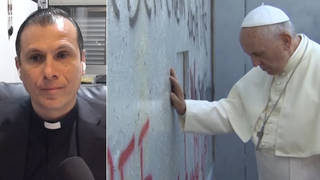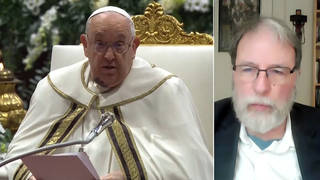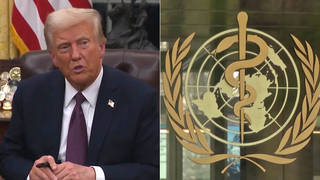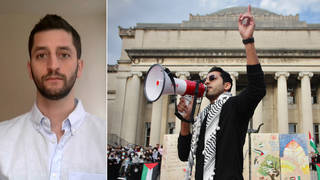
Topics
Guests
- Dr. Craig Spenceremergency room doctor and director of global health in emergency medicine at Columbia University Medical Center.
The number of confirmed U.S. coronavirus cases has officially topped 2 million as states continue to ease stay-at-home orders and reopen their economies and more than a dozen see a surge in new infections. “I worry that what we’ve seen so far is an undercount and what we’re seeing now is really just the beginning of another wave of infections spreading across the country,” says Dr. Craig Spencer, director of global health in emergency medicine at Columbia University Medical Center.
Transcript
AMY GOODMAN: I certainly look forward to the day you’re sitting here in the studio right next to me, but right now the numbers are grim. The number of confirmed U.S. coronavirus cases has officially topped 2 million in the United States, the highest number in the world by far, but public health officials say the true number of infections is certain to be many times greater. Officially, the U.S. death toll is nearing 113,000, but that number is expected to be way higher, as well.
This comes as President Trump has announced plans to hold campaign rallies in several states that are battling new surges of infections, including Florida, Texas, North Carolina and Arizona — which saw cases rise from nearly 200 a day last month to more than 1,400 a day this week.
On Tuesday, the country’s top infectious disease expert, Dr. Anthony Fauci, called the coronavirus his worst nightmare.
DR. ANTHONY FAUCI: Now we have something that indeed turned out to be my worst nightmare: something that’s highly transmissible, and in a period — if you just think about it — in a period of four months, it has devastated the world. … And it isn’t over yet.
AMY GOODMAN: This comes as Vice President Mike Pence tweeted — then deleted — a photo of himself on Wednesday greeting scores of Trump 2020 campaign staffers, all of whom were packed tightly together, indoors, wearing no masks, in contravention of CDC guidelines to stop the spread of the coronavirus.
Well, for more, we’re going directly to Dr. Craig Spencer, director of global health in emergency medicine at Columbia University Medical Center. His recent piece in The Washington Post is headlined “The strange new quiet in New York emergency rooms.”
Dr. Spencer, welcome back to Democracy Now! It’s great to have you with this, though this day is a very painful one. Cases in the United States have just topped 2 million, though that number is expected to be far higher, with the number of deaths at well over 113,000, we believe, Harvard University predicting that that number could almost double by the end of September. Dr. Craig Spencer, your thoughts on the reopening of this country and what these numbers mean?
DR. CRAIG SPENCER: That’s a really good question. So, when you think about those numbers, remember that very early on, in March, in April, when I was seeing this huge surge in New York City emergency departments, we weren’t testing. We were testing people that were only being admitted to the hospital, so we were knowingly sending home, all across the epicenter, people that were undoubtedly infected with coronavirus, that are not included in that case total. So you’re right: The likely number is much, much higher, maybe 5, 10 times higher than that.
In addition, we know that that’s true for the death count, as well. This has become this political flashpoint, talking about how many people have died. We know that it’s an incredible and incalculable toll, over 100,000. Within the next few days, we’ll have more people that have died from COVID than died during World War I here in the United States. So that’s absolutely incredible.
We know that, also, just because New York City was bad, other places across the country might not get as bad, but that doesn’t mean that they’re not bad. So, we had this huge surge, of a bunch of deaths in New York City, you know, over 200,000 cases, tens of thousands of deaths. What we’re seeing now is we’re seeing this virus continue to roll across this country, causing these localized outbreaks.
And this is, I think, going to be our reality, until we take this serious, until we actually take the actions necessary to stop this virus from spreading. Opening up, like we’ve seen in Arizona and many other places, is exactly counter to what we need to be doing to keep this virus under control. So, yeah, I worry that what we’ve seen so far is an undercount and what we’re seeing now is really just the beginning of another wave of infections spreading across the country.
NERMEEN SHAIKH: Well, Dr. Spencer, I want to ask — it’s not just in the U.S. that cases have hit this dreadful milestone. Worldwide, cases have now topped 7 million, although, like the U.S., the number is likely to be much higher because of inadequate testing all over the world. But I’d like to focus on the racial dimension of the impact of coronavirus, not just in the U.S., but also worldwide. Just as one example, in Brazil — and this is a really stunning statistic — that in Rio’s favelas, more people have died than in 15 states in Brazil combined. So, could you talk about this, both in the context of the U.S., and explain whether that is still the case, and what you expect in terms of this racial differential, how it will play out as this virus spreads?
DR. CRAIG SPENCER: Absolutely. What we’re seeing, not just in the United States, but all over the world, is coronavirus is amplifying these racial and ethnic inequities. It is impacting disproportionately vulnerable and already marginalized populations.
Starting here in the U.S., if you think about the fact, in New York City, the likelihood of dying from coronavirus was double if you’re Black or African American or Latino or Hispanic, double than what it was for white or Asian New Yorkers, so we already know that this disproportionate impact on already marginalized and vulnerable communities exists here in the United States, in the financial capital of the world. It’s the same throughout the U.S. A lot of the data that we’re seeing over the past few days, as we’re getting this disaggregated data by race and ethnic background, is that it is hitting these communities much harder than it is hitting white and other communities in the United States.
The statistics that you give for Brazil are being played out all over the world. We know that communities that already lack access to good healthcare or don’t have the same economic ability to stay home and participate in social distancing are being disproportionately impacted.
That is why we need to focus on and think about, in our public health messaging and in our public health efforts, to think about those communities that are already on the margins, that are already vulnerable, that are already suffering from chronic health conditions that may make them more likely to get infected with and die from this disease. We need to think about that as part of our response, not just in New York, not just in the U.S., but in Brazil, in Peru, in Ecuador, in South Africa, in many other countries, where we’re seeing the disproportionate number of cases coming from now.
We’re seeing — you know, I think it was just pointed out that three-quarters of all the new cases, the record-high cases, over 136,000 this past weekend on one day, three-quarters of those are coming from just 10 countries. And we know that that will continue, and it will burn through those countries and will continue through many more.
As of right now, we haven’t seen huge numbers in places like West Africa and East Africa, sub-Saharan Africa, where many people were concerned about initially. Part of that is because they have in place a lot of the tools from previous outbreaks, especially in West Africa around Ebola. But it may be that we need more testing. It may be that we’re still waiting to see the big increase in cases that may eventually hit there, as well.
NERMEEN SHAIKH: Dr. Spencer, you mentioned that on Sunday — it was Sunday where there were 136,000 new infections, which was a first. It was the highest number since the virus began. But even as the virus is spreading, much like states opening in the U.S., countries are also starting to reopen around the world, including countries that have now among the highest outbreaks. Brazil is now second only to the U.S. in the number of infections, and Russia is third, and these countries are opening, along with India and so on. So, could you — I mean, there are various reasons that countries are opening. A lot of them are not able — large numbers of people are not able to survive as long as the country is closed, like, in fact, Brazil and India. So what are the steps that countries can take to reopen safely? What is necessary to arrest the spread of the virus and allow people at the same time to be out?
DR. CRAIG SPENCER: It’s tough, because we know that this virus cannot infect you if this virus does not find you. If there’s going to be people in close proximity, whether it’s in India or Illinois, this virus will pass and will infect you. I have a lot of concern, much as you pointed out, places like India, 1.3 billion people, where they’re starting to open up after a longer period of being locked down, and case numbers are steadily increasing.
You’re right that a lot of people around the world don’t have access to multitrillion-dollar stimulus plans like we do in the United States, the ability to provide at least some sustenance during this time that people are being forced at home. Many people, if they don’t go outside, don’t eat. If they don’t work, you know, their families can’t pay rent or really just can’t live.
What do we do? We rely on the exact same tools that we should be relying on here, which is good public health principles. You need to be able to locate those people who are sick, isolate them, remove them from the community, and try to do contact tracing to see who they potentially have exposed. Otherwise, we’re going to continue to have people circulating with this virus that can continue to infect other people.
It’s much harder in places where people may not have access to a phone or may not have an address or may not have the same infrastructure that we have here in the United States. But it’s absolutely possible. We’ve done this with smallpox eradication decades ago. We need to be doing this good, simple, bread-and-butter, basic public health work all around the world. But that takes a lot of commitment, it takes a lot of money, and it takes a lot of time.
AMY GOODMAN: It looks like President Trump is reading the rules and just doing the opposite — I mean, everything from pulling out of the World Health Organization, which — and if you could talk about the significance of this? You’re a world health expert. You yourself survived Ebola after working in Africa around that disease. And also here at home, I mean, pulling out of Charlotte, the Republican convention, because the governor wouldn’t agree to no social distancing, and he didn’t want those that came to the convention to wear masks. If you can talk about the significance, what might seem trite to some people, but what exactly masks do? And also, in this country, the states we see that have relaxed so much — he might move, announce tomorrow, the convention to Florida. There’s surges there. There’s surges in Arizona, extremely desperate question of whether a lockdown will be reimposed there. What has to happen? What exactly, when we say testing, should be available? And do you have enough masks even where you work?
DR. CRAIG SPENCER: Great. Yes. So, let me answer each of those. I think, first, on the World Health Organization, and really the rhetoric that is coming from the White House, it needs to be one of global solidarity right now. We are not going to beat this alone. I think that that’s been proven. This idea of American exceptionalism now is only true in that we have the most cases of anywhere in the world. We are not going to beat this alone. No country is going to beat this alone. As Dr. Fauci said, this is his worst nightmare. It’s my worst nightmare, as well. This is a virus that was first discovered just months ago, and has now really taken over the world. We need organizations like the World Health Organization, even if it isn’t perfect. And I’ve had qualms with it in the past. I’ve written about it, I’ve spoken about it, about the response as part of the West Africa Ebola outbreak that I witnessed firsthand. But at the end of the day, they do really, really good work, and they do the work that other organizations, including the United States, are not doing around the world, and that protects us. So, we absolutely, despite their imperfections, need to further invest and support them.
In terms of masks, masks may be, in addition to social distancing, one of the few things that really, really helps us and has proven to decrease transmission. We know that if a significant proportion of society — you know, 60, 70, 80% of people — are wearing masks, that will significantly decrease the amount of transmission and can prevent this virus from spreading very rapidly. Everyone should be wearing masks. I think, in the United States right now, we should consider the whole country as a hot zone. And the risk of transmission being very high, regardless of whether you’re in New York or North Dakota, people should be wearing a mask when they’re going outside and when they’re interacting with others that they generally don’t interact with.
We know the science is good. I will say that from a public health perspective, there was some initial reluctance and, really, I guess, some confusion early on about whether people should be using masks. We didn’t have a lot of the science to know whether it would help. We do now. And thankfully, we’re changing our recommendations.
We also were concerned about the availability of masks early on. As you mentioned, there was questions around availability of personal protective equipment, whether we had enough in hospitals to provide care while keeping providers safe. It’s better now, but there are still a lot of people who are saying that they’re reusing masks, that we still need more personal protective equipment. So, for the moment, everyone should be wearing a mask.
AMY GOODMAN: And for the protests outside?
DR. CRAIG SPENCER: Absolutely. Yeah, of course. Just because I think we have personal passions around public health crises, that doesn’t prevent us from being infected. From a public health perspective, of course I have concerns that people who are close and are yelling and are being tear-gassed and are not wearing masks, if that’s all the case, it’s certainly an environment where the coronavirus could spread.
So, what I’ve been telling everyone that’s protesting is exercise your right to protest — I think that’s great — but be safe. We are in a pandemic. We’re in a public health emergency. Wear a mask. Socially distance as much as you possibly can. Wash your hands.
AMY GOODMAN: And are you telling the authorities to stop tear-gassing and pepper-spraying the protesters?
DR. CRAIG SPENCER: I mean, well, one, it’s illegal. You should definitely stop tear-gassing. We know that what happens when people get tear-gassed is they cough, and it increases the secretions, which increases the risk. It increases the transmissibility of this virus.
In addition to that, you know, holding people and arresting them and putting them into small cells with others without masks is also, as we’ve seen from this huge number of cases in places like meatpacking plants or in jails, in prisons, the number of cases have been extremely high in those places. Putting people into holding cells for a prolonged period of time is not going to help; it’s definitely going to increase the transmissibility of this virus.
So, yes, everyone should be wearing a mask. I think everyone should have a mask on when you’re anywhere that your interacting with others can potentially spread this.
I think your other question was around testing. We know that right now testing has significantly increased in the U.S. Is it adequate? No, I don’t think so. I know I hear from a lot of people who say they still have to drive two to three hours to get a test. We still have questions around the reliability of some of serology tests, or the antibody tests. Those are the tests that will tell you whether or not you’ve been previously exposed and now have antibodies to the disease. Some of the more readily available tests just aren’t that great. And so, we can’t use them yet to make really widespread decisions on who might have antibodies, who might have protection and who can maybe more safely go back into society without the fear of being infected.
NERMEEN SHAIKH: Dr. Spencer, we just have 30 seconds. Very quickly, there are 135 vaccines in development. What’s your prognosis? When will there be a vaccine or a drug treatment?
DR. CRAIG SPENCER: We have one drug that shortens the time that people are sick. We don’t know about the impact on mortality. There are other treatments that are in process now. Hopefully some of them work.
In terms of vaccines, we will have a vaccine, very likely, that we know is effective, probably at some time later this year. The bigger process is going to be how do we scale it up to make hundreds of millions of doses; how do we do it in a way that we can get it to all of the people that deserve it, not just the people that can pay for it. I think these are going to be some of the bigger questions and bigger problems that we’re going to face, going forward. But I’m optimistic that we’ll have a vaccine or many vaccines, hopefully, in the next year.
AMY GOODMAN: Dr. Craig Spencer, we want to thank you so much for being with us, director of global health in emergency medicine at Columbia University Medical Center. And thank you so much for your work as an essential worker. Dr. Spencer’s recent piece, we’ll link to at democracynow.org. It’s in The Washington Post, headlined “The strange new quiet in New York emergency rooms.”
When we come back, George Floyd’s brother testifies before Congress, a day after he laid his brother to rest. Stay with us.













Media Options